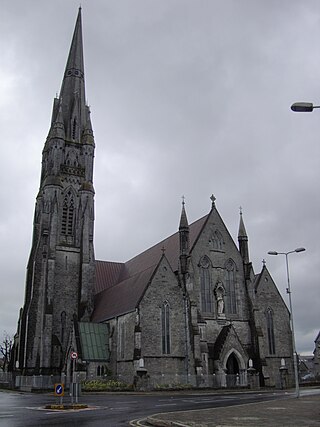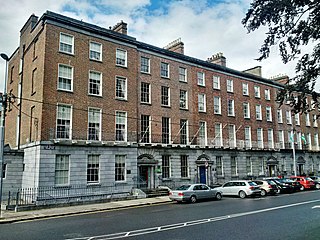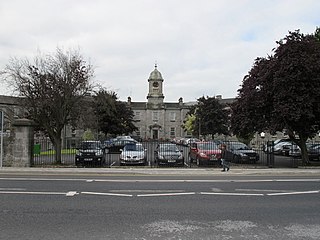Related Research Articles

Roscrea is a market town in County Tipperary, Ireland, which in 2016 had a population of 5,446. Roscrea is one of the oldest towns in Ireland, having developed around the 7th century monastery of Saint Crónán of Roscrea, parts of which remain preserved today.

Adare is a village in County Limerick, Ireland, located southwest of the city of Limerick. Adare is designated as a heritage town by the Irish government. The village is in a townland and civil parish of the same name.

As with other cities in Ireland, Limerick has a history of great architecture. A 1574 document prepared for the Spanish ambassador attests to its wealth and fine architecture:

St. John's Cathedral is a Roman Catholic cathedral in Limerick, Ireland. Designed by the architect Philip Charles Hardwick, ground was broken in 1857 and the first Mass celebrated on 7 March 1859. It replaced a chapel founded in 1753.

Galbally is a village in southeast County Limerick, Ireland, on the border with County Tipperary. It is located at the foot of the Galtee Mountains and at the western approach to the Glen of Aherlow. The Aherlow River, flowing down from the Galtee mountains, runs by the village, to meet the Suir at Kilmoyler a short distance north of Cahir. Galbally is in a valley overlooked by the Galtee Mountains. The village is in a townland and civil parish of the same name.

Ballingarry is a village in County Limerick, Ireland. It is located near the village of Granagh and between the towns of Rathkeale and Kilmallock on the R518 road. Ballingarry lies in a civil parish of the same name, and within the ecclesiastical parish of Ballingarry-Granagh in the Roman Catholic Diocese of Limerick. The village had a population of 570 as of the 2022 census, up from 521 at the 2016 census.

Anne Elizabeth "Elsie" Fogerty was a British teacher who departed from the customary practice of "voice and diction" also called elocution. At that time "Voice and Diction" focused entirely on the mouth and nasal cavity to produce speech sounds. Fogerty's technique ended up focusing on the entire body and voice to produce speech. At first, she used just the lungs to resonate the sound, but soon included the whole body, because she discovered that posture and movement also affected speech. It ultimately became known as the "Body and Voice" technique. She was founder and principal of the Central School of Speech and Drama in London from 1906 to 1942.

Moneygall is a village on the border of counties Offaly and Tipperary, in Ireland. It is situated on the R445 road between Dublin and Limerick. There were 374 people living in the village as of the 2022 census. Moneygall has a Catholic church, motorway service station, a car sales and repair centre, a national school, a Garda station and two pubs. The nearest Church of Ireland church, Borrisnafarney, is 2 km from the village beside the former Loughton Demesne.

Edmund Sexton Pery, 1st Viscount Pery was an Anglo-Irish politician who served as Speaker of the Irish House of Commons between 1771 and 1785.
William Fogerty, FRIAI, FRIBA, AAI was an Irish architect active in mid-nineteenth-century Limerick, London, New York City and Dublin.
Joseph Fogerty, CE, FRIBA, (1831-1899) was an Irish civil engineer, architect, and novelist active in mid-to-late-nineteenth-century Limerick, London, and Vienna.

John Fogerty was an Irish millwright, architect, builder, and civil engineer, active in early to mid-19th-century Limerick.He was the brother of Joseph Fogerty Sr. and the father of engineer and novelist Joseph Fogerty of London, architect William Fogerty of Dublin, and grandfather of architect John Frederick Fogerty. He retired as an architect sometime between 1870 and 1879.
John Frederick Fogerty (1863–1938), was an Irish architect and engineer active late 19th-century Limerick, London, Shropshire, Bournemouth, Pretoria, and Zambia. Born in Limerick, he was the son of architect William Fogerty, grandson of architect and engineer John Fogerty (engineer), and nephew of engineer and novelist Joseph Fogerty. He earned a bachelor's degree in engineering from Queen's College, Cork in 1883, and attended the South Kensington Art School the year later. He was articled to Sir Thomas Drew. In 1889, he established his office at Wellington, Shropshire, and entered into partnership with Reginald George Pinder in Bournemouth in 1893, later amalgamating Pearce & Parnell of Bournemouth in 1902. He emigrated to South Africa in 1914 and enlisted at the outbreak of the First World War, serving time in South Africa, the Isle of Wight, Palestine, and Poona, India. During the interwar period, he worked as an engineer in Pretoria's Public Works Department, before becoming borough surveyor in Lusaka, Zambia, in 1926, where he died in 1938.
Joseph Fogerty Sr. was an Irish builder and architect active in nineteenth-century Limerick. Born in Limerick into a family of builders, he was the father of Robert Fogerty and George J. Fogerty; brother of John Fogerty (engineer), uncle of engineer and novelist Joseph Fogerty of London and architect William Fogerty of Dublin, and great uncle of architect John Frederick Fogerty. He designed and built the Theatre Royal, Limerick, Henry Street. From the 1870s until his death, he was partners with his son Robert in the firm Joseph Fogerty & Son.

Newtown Pery is an area of central Limerick, Ireland, and forms the main city centre of the city. The district is known for its Georgian architectural heritage and is the core area of Limerick's Georgian Quarter. It is one of the three towns that make up modern-day Limerick City Centre, the other two being the older Englishtown and Irishtown, which date from the medieval period. Newtown Pery houses the largest collection of Georgian townhouses in Ireland outside of Dublin. In 1837, Samuel Lewis in his Topographical Dictionary of Ireland described Newtown Pery as "one of the handsomest towns in Ireland".

Pery Square is a Georgian Terrace located in the Newtown Pery area of Limerick city, Ireland. The terrace was constructed as a speculative development by the Pery Square Tontine Company between 1835 and 1838. The square was named in honour of the politician Edmund Sexton Pery. The terrace is notable as one of the finest examples of late Georgian architecture in Limerick and Ireland.

Edward Newenham Hoare, a graduate of Trinity College, Dublin was an Irish Anglican priest: he was Archdeacon of Ardfert from 1836 to 1839, then Dean of Achonry from 1839 to 1850; and Dean of Waterford from then until his death.
James Joseph McCarthy was an Irish architect known for his design of ecclesiastical buildings. McCarthy was born in Dublin, Ireland on 6 January 1817. His parents were from County Kerry. He was educated by the Christian Brothers in Richmond St., and went on to study architecture at the Royal Dublin Society School. He was a follower of the style of the architect Pugin and Gothic Revival.

St. Joseph's Hospital is a psychiatric hospital in Limerick, County Limerick, Ireland.
References
- 1 2 3 Irish Architectural Archive, Dictionary of Irish Architects 1720-1940. FOGERTY & SONS, JOSH (Accessed 12 Oct 2010)